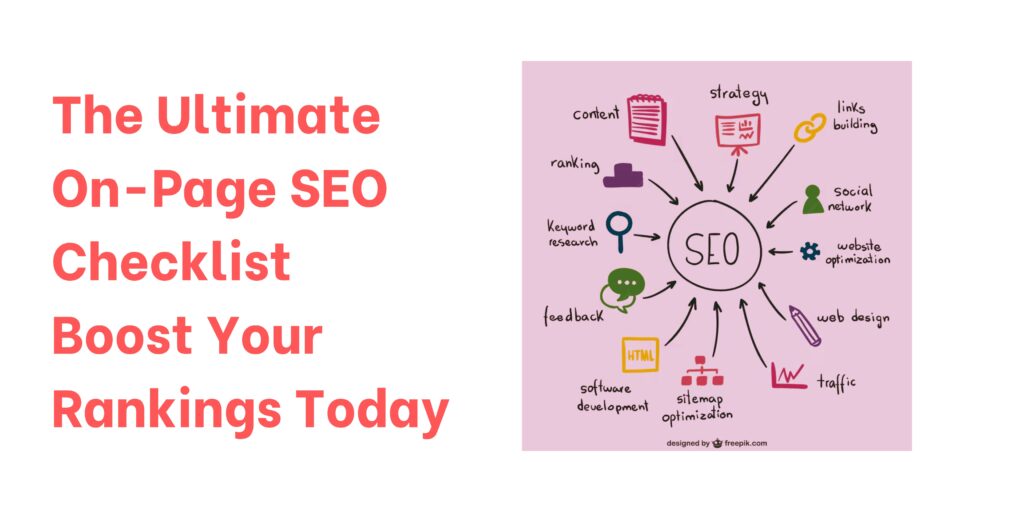Staying ahead in the ever-evolving SEO landscape requires mastering the latest on-page SEO techniques. As search engines become smarter, businesses must refine their strategies to rank higher and drive organic traffic. This comprehensive on-page SEO checklist for 2025 will equip you with the best practices and step-by-step on-page SEO guide for 2025 to optimize your website and outperform competitors.
1. Optimize Title Tags & Meta Descriptions
Your title tag and meta description are the first things users see in search results. Crafting compelling, keyword-rich, and engaging meta elements can significantly boost click-through rates (CTR).
✅ Best Practices:
✔ Keep title tags under 60 characters with primary keywords (e.g., “The Ultimate On-Page SEO Checklist for 2025”)
✔ Write unique meta descriptions under 160 characters, incorporating secondary keywords naturally
✔ Avoid keyword stuffing and focus on user intent
2. Perfect Your Header Tags (H1-H6)
Header tags (H1, H2, H3, etc.) structure your content and improve readability. Search engines use these to understand topic hierarchy.
✅ Best Practices:
✔ Use a single H1 tag for the main title, including your primary keyword
✔ Use H2 and H3 tags for subheadings and include relevant long-tail keywords
✔ Keep headers engaging, descriptive, and aligned with user queries
3. Content Optimization: Write for Humans & Search Engines
High-quality, engaging content is the backbone of on-page SEO strategies 2025.
✅ Best Practices:
✔ Write informative, unique, and valuable content that solves user queries
✔ Maintain a conversational and engaging tone while naturally integrating keywords
✔ Aim for at least 1,500 words for in-depth coverage and better rankings
✔ Include bullet points, numbered lists, and short paragraphs for easy readability
4. Keyword Placement & Optimization
Keywords are still essential, but their placement and density should be strategic rather than excessive.
✅ Best Practices:
✔ Use primary keywords in the title tag, first 100 words, and last paragraph
✔ Incorporate long-tail and LSI keywords naturally throughout the content
✔ Optimize for semantic search by answering related user queries
✔ Avoid overstuffing; focus on contextual relevance
5. Image & Multimedia Optimization
Images, videos, and infographics improve user experience, engagement, and rankings.
✅ Best Practices:
✔ Use descriptive file names and alt text with relevant keywords
✔ Compress images to improve page load speed (WebP format recommended)
✔ Implement structured data (Schema Markup) for visual elements
✔ Add captions where necessary for context and accessibility
6. Internal & External Linking Strategies
Linking improves website authority, navigation, and user experience.
✅ Best Practices:
✔ Link to high-authority external sources to back up claims
✔ Use descriptive anchor text for internal links
✔ Ensure a well-structured internal linking strategy for better indexation
✔ Avoid excessive linking, keeping it relevant and valuable
7. Core Web Vitals & Page Speed Optimization
Google prioritizes user experience metrics, including Core Web Vitals.
✅ Best Practices:
✔ Optimize Largest Contentful Paint (LCP) under 2.5 seconds
✔ Improve First Input Delay (FID) for smooth interactivity
✔ Enhance Cumulative Layout Shift (CLS) for stable visual elements
✔ Use CDNs, caching, and lazy loading to improve speed
8. Mobile-First Optimization
With mobile-first indexing, your website must perform well on smartphones.
✅ Best Practices:
✔ Ensure a responsive design that adapts to different screen sizes
✔ Use legible font sizes and easily tappable elements
✔ Optimize images and videos for mobile performance
✔ Test mobile usability with Google’s Mobile-Friendly Test
9. Schema Markup & Rich Snippets
Structured data helps search engines understand your content better.
✅ Best Practices:
✔ Implement FAQ, How-To, and Review Schema for enhanced visibility
✔ Use JSON-LD format for seamless integration
✔ Validate structured data with Google’s Rich Results Test
10. User Experience (UX) & Engagement Signals
Google considers engagement metrics like bounce rate, dwell time, and CTR.
✅ Best Practices:
✔ Ensure clear navigation and intuitive site structure
✔ Improve readability with short paragraphs, visuals, and bullet points
✔ Encourage engagement with call-to-actions (CTAs) and interactive elements
Final Thoughts
Mastering top on-page SEO techniques to boost rankings in 2025 requires a user-first approach, focusing on content, UX, and technical optimizations. Use this on-page SEO checklist 2025 to keep your website in top shape and ensure higher visibility, better engagement, and improved rankings.
Need Expert SEO Help?
SEO is always evolving! Stay ahead by following SEO For Ranking for expert tips, case studies, and actionable SEO strategies. 🚀
